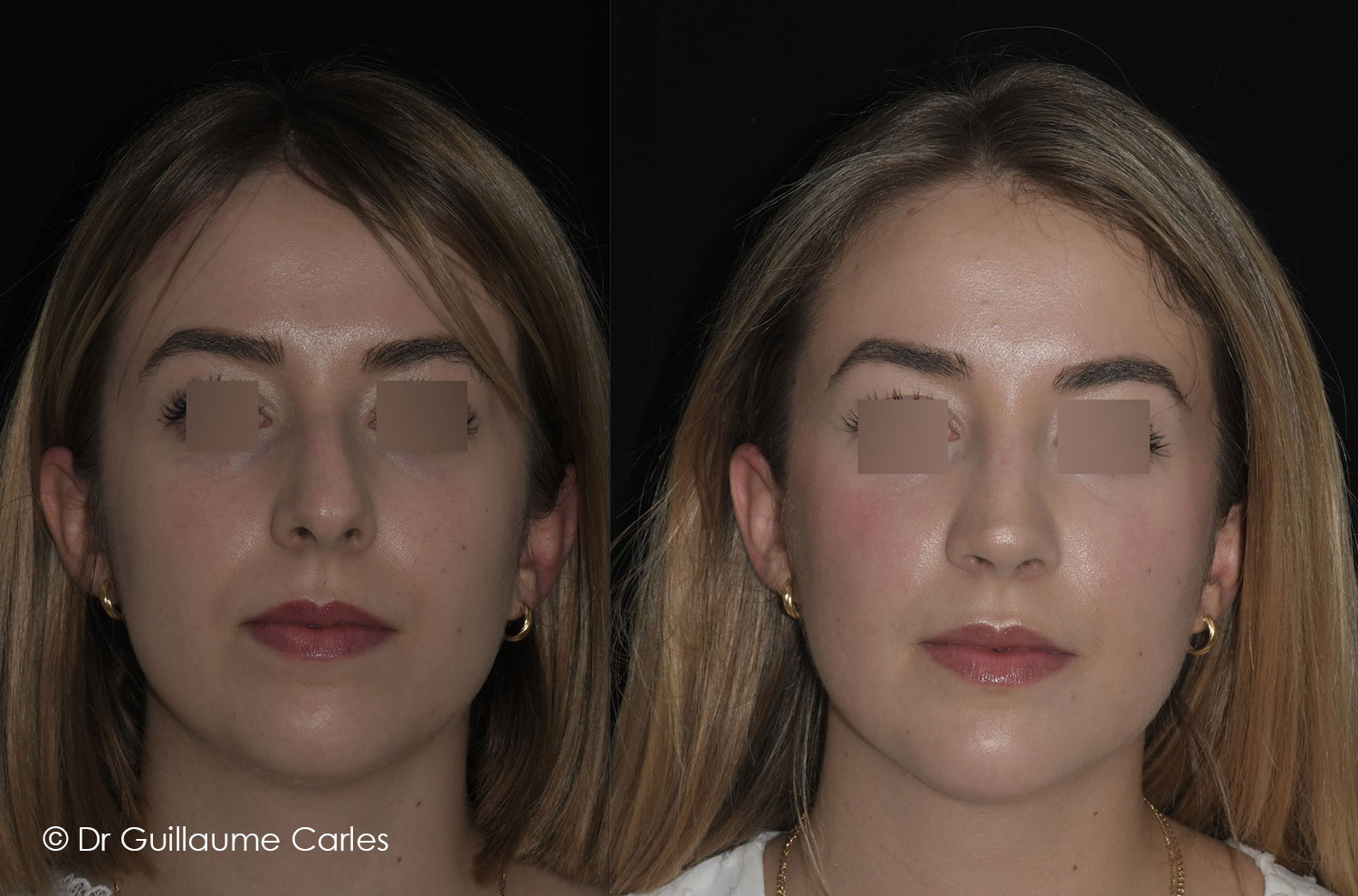Rhinoplasty
Aesthetic and reconstructive nose surgery
Rhinoplasty, commonly known as nose surgery or cosmetic nose surgery, is a surgical procedure to change the shape, size or function of the nose.
This is a surgical operation offered to patients with a nasal deformity and/or an aesthetic particularity.
This intervention is called “primary” if it is a first intervention and otherwise, is called “revision".
Rhinoplasty is called “functional” in the event of associated nasal obstruction.
When is rhinoplasty used?
Correction of birth defects:
Some people are born with structural abnormalities of the nose such as nasal deformities, a deviated nasal septum or malformations of the nasal cartilages. Rhinoplasty may be necessary to correct these birth defects and improve respiratory functionality.
Trauma correction:
Accidents, falls or sports injuries can cause nasal fractures or other structural damage to the nose.
In these cases, rhinoplasty may be necessary to repair damage and restore the natural appearance of the nose.
Aesthetics improvement:
Many patients consider rhinoplasty for cosmetic reasons to change the shape or size of their nose.
This may include reducing the nasal hump, straightening the nose hooked, refinement of the tip of the nose or correction of asymmetrical proportions.
Improved respiratory function:
Nasal breathing problems due to structural obstructions such as a deviated nasal septum, enlarged turbinates, or other abnormalities may require functional rhinoplasty to improve breathing and quality of life of the patient.
Correction of a previous rhinoplasty:
In some cases, a previous rhinoplasty may not have produced the desired results or may have led to complications.
A repeat rhinoplasty may be necessary to correct any imperfections or defects. resulting from the previous surgical procedure.
This highly technical procedure is called secondary rhinoplasty.
A rhinoplasty by Dr Guillaume Carles
#CarlesRhinoplasty
A “natural rhinoplasty”
Each surgeon has his own aesthetic. Dr. Carles focuses particularly on correcting the nose by obtaining the most natural result possible and in harmony with the rest of the face, whilst taking into account the patient's expectations. In addition, a great part of the intervention will be devoted to strengthening the structures and camouflaging any imperfections, with the aim of avoiding a “surgical look” in the long term.
State-of-the-art techniques
Dr Carles, present at numerous international conferences, is an accredited trainer by the European Academy of Facial Plastic Surgery.
He teaches international surgeons the latest technical innovations in rhinoplasty.
Types of rhinoplasty
Aesthetic rhinoplasty:
It aims to improve the appearance of the nose. Changes may include reducing the size of the nose, reshaping the tip, straightening the nasal dorsum (the upper part of the nose), or correcting the width of the nostrils.
Functional rhinoplasty:
A rhinoplasty is said to be functional when a respiratory problem is associated with the aesthetic problem.
In general, it is a nasal deviation which appears either at the time of facial growth, or following a trauma.
Ultrasonic rhinoplasty:
Since 2016, Dr. Carles has been equipped with the rhinosculpture or ultrasonic rhinoplasty system.
Piezoelectric inserts have the ability to act selectively on bones and/or hard cartilage, without damaging the soft tissues: skin, mucous membranes and fragile cartilages such as the upper lateral cartilages and the lower lateral cartilages.
These tools make it possible to improve the finesse of the aesthetic results and to reduce post-operative edema, by replacing traditional chisels.
Preservative rhinoplasty:
The principle of conservative rhinoplasty is to preserve the architecture of the back of the nose, which will be impacted in depth, this is known as the "push-down". This technique, which can only be offered to a portion of patients wishing surgery, has the advantage of shortening the duration of the operation and reducing post-operative edema.
Secondary rhinoplasty:
Secondary rhinoplasty is a surgical technique which makes it possible to modify the nose of a person who has already undergone rhinoplasty.
It can be offered to correct the unsatisfactory results of a rhinoplasty or to improve already satisfactory results.
Ethnic rhinoplasty:
A rhinoplasty is called "ethnic" when it is offered to patients of African or Asian origin. In these cases, the request is generally to increase the size of the back of the nose, while maintaining the most natural and harmonious shape possible. It is common to propose nostril reduction in patients of African origin.
Reconstructive rhinoplasty:
This procedure is carried out to correct nasal defects caused by trauma.
Trauma can be linked to a road accident or an assault. It is generally necessary to wait 6 months before rhinoplasty.
Malformative rhinoplasty: cleft lip and palate and frontonasal dysplasia
Certain congenital malformations such as cleft lip and palate and frontonasal dysplasia frequently lead to nasal deformity, sometimes with respiratory problems. Depending on the case, rhinoplasty will be offered before or after adolescence.
Patients with cleft lip often have a deviated septum which will require surgery to improve respiratory function.
Rhinoplasty for Wegener's disease / Granulomatosis with polyangiitis:
Wegener's disease, a disease of autoimmune origin, causes destruction of the cartilage of the nasal septum.
A restorative intervention is offered once the disease has stabilized, with the approval of the referring internist doctor.
It is generally offered after 2 years of progression of the disease. In these cases, it is necessary to perform a costal cartilage graft in order to reconstruct the architecture that has been destroyed by the disease.
Non-surgical rhinoplasty:
This approach uses injections of hyaluronic acid or other fillers to temporarily change the shape of the nose without the need for surgery.
Rhinoplasty in practice
The consultation
A first consultation with Doctor Carles will allow you to explain your goals and to have an idea of what can be done.
A computer generated modelling by “morphing” will be offered to you.
These consultations for rhinoplasty take place in Montpellier or Paris.
Before a first consultation, it is possible to submit your file via a contact form, with the option of securely sending photos.
The operation
Rhinoplasty operations take place in Montpellier in the Clémentville or St Roch clinics ideally located in town.
The principles of the intervention will be explained to you during the consultation with Dr. Carles.
The rhinoplasty procedure is carried out under general anaesthesia on an outpatient basis (exit in the evening) or during a brief hospitalization (exit the next day). Depending on the case, the incision will be hidden inside the nose or with the size of a small scar at the base of the nose. It is usual to place a light resin retainer on the back of the nose and thin plates in the nostrils (septum splints), for 5 to 7 days. There are no highlights.
Operative consequences
The first post-operative consultation takes place between the 6th and 9th day.
It takes approximately 10 minutes for this consultation during which nasal splints will be removed.
The marks of the operation disappear very quickly, patients can return to work between 10 and 15 days after the operation. The result remarkably improves during the first few weeks, then slowly over several months.
The final result is generally obtained 1 year after the operation. For patients living remotely, it is possible to organize a follow-up by videoconsultation.








